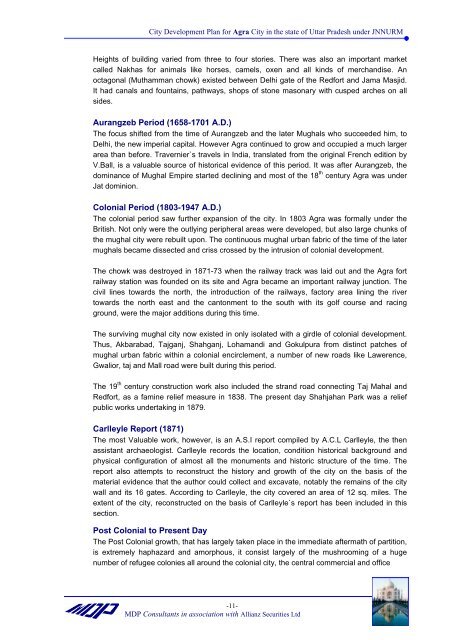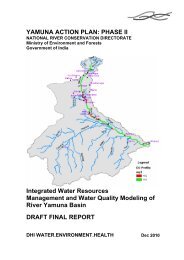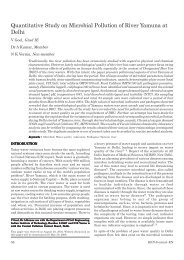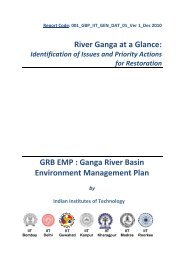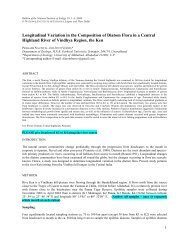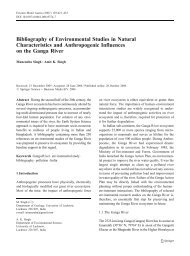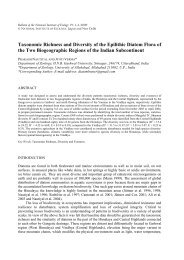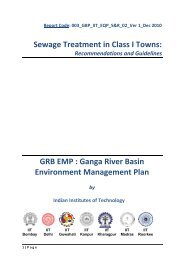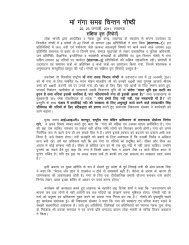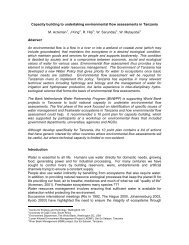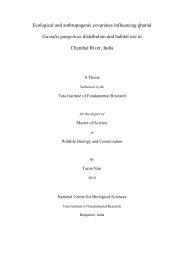JNNURM - GANGAPEDIA
JNNURM - GANGAPEDIA
JNNURM - GANGAPEDIA
Create successful ePaper yourself
Turn your PDF publications into a flip-book with our unique Google optimized e-Paper software.
City Development Plan for Agra City in the state of Uttar Pradesh under <strong>JNNURM</strong><br />
Heights of building varied from three to four stories. There was also an important market<br />
called Nakhas for animals like horses, camels, oxen and all kinds of merchandise. An<br />
octagonal (Muthamman chowk) existed between Delhi gate of the Redfort and Jama Masjid.<br />
It had canals and fountains, pathways, shops of stone masonary with cusped arches on all<br />
sides.<br />
Aurangzeb Period (1658-1701 A.D.)<br />
The focus shifted from the time of Aurangzeb and the later Mughals who succeeded him, to<br />
Delhi, the new imperial capital. However Agra continued to grow and occupied a much larger<br />
area than before. Travernier`s travels in India, translated from the original French edition by<br />
V.Ball, is a valuable source of historical evidence of this period. It was after Aurangzeb, the<br />
dominance of Mughal Empire started declining and most of the 18 th century Agra was under<br />
Jat dominion.<br />
Colonial Period (1803-1947 A.D.)<br />
The colonial period saw further expansion of the city. In 1803 Agra was formally under the<br />
British. Not only were the outlying peripheral areas were developed, but also large chunks of<br />
the mughal city were rebuilt upon. The continuous mughal urban fabric of the time of the later<br />
mughals became dissected and criss crossed by the intrusion of colonial development.<br />
The chowk was destroyed in 1871-73 when the railway track was laid out and the Agra fort<br />
railway station was founded on its site and Agra became an important railway junction. The<br />
civil lines towards the north, the introduction of the railways, factory area lining the river<br />
towards the north east and the cantonment to the south with its golf course and racing<br />
ground, were the major additions during this time.<br />
The surviving mughal city now existed in only isolated with a girdle of colonial development.<br />
Thus, Akbarabad, Tajganj, Shahganj, Lohamandi and Gokulpura from distinct patches of<br />
mughal urban fabric within a colonial encirclement, a number of new roads like Lawerence,<br />
Gwalior, taj and Mall road were built during this period.<br />
The 19 th century construction work also included the strand road connecting Taj Mahal and<br />
Redfort, as a famine relief measure in 1838. The present day Shahjahan Park was a relief<br />
public works undertaking in 1879.<br />
Carlleyle Report (1871)<br />
The most Valuable work, however, is an A.S.I report compiled by A.C.L Carlleyle, the then<br />
assistant archaeologist. Carlleyle records the location, condition historical background and<br />
physical configuration of almost all the monuments and historic structure of the time. The<br />
report also attempts to reconstruct the history and growth of the city on the basis of the<br />
material evidence that the author could collect and excavate, notably the remains of the city<br />
wall and its 16 gates. According to Carlleyle, the city covered an area of 12 sq. miles. The<br />
extent of the city, reconstructed on the basis of Carlleyle`s report has been included in this<br />
section.<br />
Post Colonial to Present Day<br />
The Post Colonial growth, that has largely taken place in the immediate aftermath of partition,<br />
is extremely haphazard and amorphous, it consist largely of the mushrooming of a huge<br />
number of refugee colonies all around the colonial city, the central commercial and office<br />
-11-<br />
MDP Consultants in association with Allianz Securities Ltd


